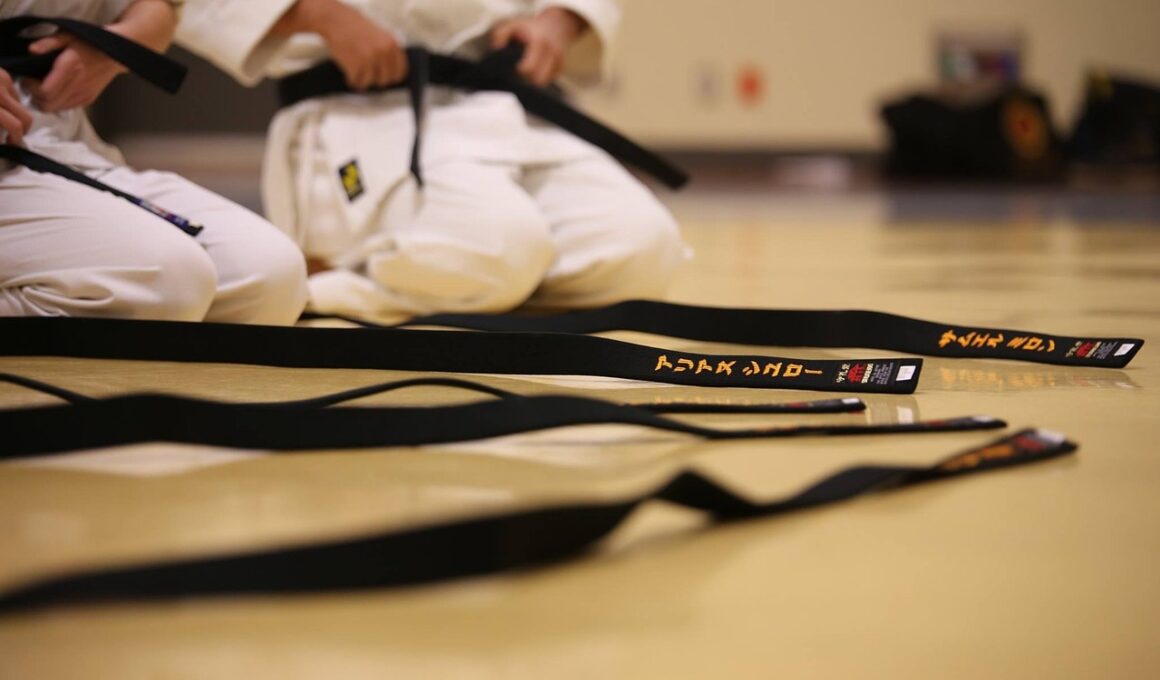Understanding Different Styles of Karate
Karate, a martial art that originated in Japan, has evolved into various styles, each emphasizing different techniques and philosophies. The major styles include Shotokan, Goju-Ryu, Shito-Ryu, and Kyokushin. These styles not only differ in their training methodologies but also in their approaches to sparring and kata. Shotokan, developed by Gichin Funakoshi, focuses on strong linear movements and deep stances. Practitioners emphasize powerful punches and kicks, incorporating a distinct, deliberate rhythm. Goju-Ryu, founded by Chojun Miyagi, balances hard and soft techniques. This style emphasizes close-range combat with powerful strikes, joint locks, and grappling techniques. Shito-Ryu combines elements from both Goju-Ryu and Shotokan, enabling students to adapt and diversify their skills. Finally, Kyokushin, known for its full-contact sparring, promotes resilience and physical toughness, resulting in a unique, combative training atmosphere. Students often engage in rigorous training sessions to improve their physical conditioning and mental fortitude. The choice of style often depends on personal preference, goals, and the dojo available in your area. Understanding these styles can greatly enrich your martial arts journey.
The Philosophy Behind Shotokan Karate
Shotokan Karate offers more than just physical techniques; it embeds a philosophy emphasizing discipline, respect, and self-improvement. The founder, Gichin Funakoshi, believed that karate should not only strengthen the body but also the spirit. Practicing Shotokan instills values such as humility and perseverance through rigorous training and repetitive drill sessions. Students are often encouraged to set personal goals, aiming to improve oneself continuously. The training methodology emphasizes strong stances and precise movements, promoting good technique and body alignment, which can be therapeutic and enhance overall health. Kata, the pre-arranged series of movements, plays a vital role, teaching balance, timing, and rhythm. Each kata has its significance, developing a practitioner’s mental focus and martial efficiency. Sparring, or kumite, in Shotokan fosters a spirit of competition, allowing students to apply techniques in a controlled yet effective manner. Far from mere fighting, Shotokan instills a sense of community and camaraderie among practitioners, gathering students of all levels to support each other. The greater purpose of Shotokan goes beyond mere self-defense, encouraging a way of life rooted in respect and dedication.
Goju-Ryu Karate, established by Chojun Miyagi, is distinctive due to its blend of hard and soft techniques. This style encourages students to develop skills in striking while also mastering various grappling and joint-lock techniques. Students learn to adapt their techniques, switching from powerful, hard strikes during combat to more fluid, circular moves when necessary. The philosophy behind Goju-Ryu emphasizes the harmony between body and spirit, advocating for a balanced approach to training. Practitioners utilize breath control and meditation to enhance their mental focus during practice. The training requires both physical strength and mental fortitude, which develops resilience in students. Kata, a vital component of Goju-Ryu, includes numerous forms that impart techniques covering various distances and situations. During kumite, or sparring, students are encouraged to think creatively, using techniques effectively to evaluate an opponent’s strengths and weaknesses. This essential aspect cultivates both mental agility and adaptability, ensuring practitioners can face diverse challenges in life. Goju-Ryu’s holistic training approach nurtures both the mind and body, creating well-rounded martial artists who embody the principles of discipline and respect.
Shito-Ryu’s Unique Techniques
Shito-Ryu Karate is known for its blend of techniques derived from both hard and soft styles, enabling practitioners to develop a wide range of skills. The founder, Kenwa Mabuni, integrated elements from both Goju-Ryu and Shotokan, creating a diverse training curriculum. Practitioners learn various techniques that range from powerful strikes to intricate evasive maneuvers. This creates flexibility in combat, allowing practitioners to adapt to different circumstances during sparring. Kata in Shito-Ryu is diverse and extensive, teaching students various martial techniques, body mechanics, and strategies. Each kata contains multiple applications, developing deeper insight into principles and techniques. Beyond physical techniques, training emphasizes the mental aspect of karate, fostering respect, discipline, and humility in students. In contrast to other styles, Shito-Ryu also includes a focus on the development of personal techniques, allowing students to innovate their approaches to training and sparring. The dojo community creates a supportive environment where practitioners of all levels come together to support each other’s growth. Choosing Shito-Ryu can provide an enriching experience, expanding a martial artist’s repertoire of skills for self-improvement.
Kyokushin Karate is distinctive for its full-contact philosophy, which emphasizes physical toughness and resilience. Developed by Masutatsu Oyama, Kyokushin practitioners focus heavily on sparring, aiming to cultivate strength, perseverance, and real-life fighting skills. The rigorous training associated with this style is designed to challenge both the body and mind, pushing students to their limits. The critical aspect of Kyokushin is its emphasis on practical application, where students engage in full-contact kumite sessions, developing realistic fighting capabilities. Hard training techniques, including conditioning exercises, are integral, preparing students for the emotional and physical stamina needed for competition. Beyond the physical aspects, Kyokushin also focuses on developing a strong character, teaching respect and humility toward opponents. The dojos often foster a sense of community, promoting friendship and camaraderie among practitioners. Additionally, the annual tournaments organized within the Kyokushin community provide practitioners with opportunities to challenge themselves and showcase their skills. Choosing Kyokushin can lead to increased confidence and self-discipline. With its unique combination of toughness and spirit, Kyokushin is a rewarding path for martial artists seeking intense training.
The Importance of Kata in Karate
Kata is a crucial aspect of all karate styles, serving as a structured sequence of movements. These forms assist practitioners in developing technique, discipline, and focus during training. Beyond mere practice, kata embodies the principles and philosophies of the specific style being studied. Each stance and movement reflects critical techniques that are essential during practical applications in combat. Practicing kata sharpens muscle memory, enhancing responsiveness during kumite, or sparring sessions. Moreover, kata aids in understanding timing, rhythm, and balance, which are crucial for effective martial arts practice. Kata also facilitates mental focus and clarity, as students must execute a predetermined sequence of movements accurately. This requires concentration, promoting mindfulness that translates into real-life applications. Additionally, kata are often performed in solo practice, allowing for self-reflection and the opportunity to refine techniques continually. Many competitions feature kata, showcasing practitioners’ skill and precision. Training in kata cultivates a deep connection to martial arts history and culture, enriching a student’s journey. The significance of kata extends beyond physical abilities, fostering a holistic development of the practitioner’s martial arts education.
The concept of dojo etiquette and respect forms the foundation of karate practice, transcending mere physical training. Dojo etiquette, or “reishiki,” is paramount across all karate styles, instilling values such as respect, humility, and discipline in students. Practitioners are expected to demonstrate kindness and consideration towards instructors and fellow students alike. Bowing upon entering and exiting the dojo is a traditional practice that signifies respect for the space and those who share it. Additionally, addressing instructors with appropriate titles fosters a culture of respect within the dojo environment. The learning atmosphere nurtures growth, emphasizing that martial arts extend beyond self-defense techniques. Instead, karate promotes ethical character and personal development, allowing students to integrate these values into their daily lives. Part of learning karate involves adopting a disciplined approach to training while valuing the skills of peers and mentors. Building camaraderie enhances the training experience, making it enjoyable and contributing to personal growth. Respect for the martial art’s history and traditions further enriches the karate journey of each practitioner.
Conclusion on Karate Styles
Understanding the various styles of karate can significantly enhance your practice and appreciation of this martial art. Each style offers unique perspectives and methods, catering to a diverse range of preferences and goals among practitioners. Some may be drawn to the powerful techniques of Shotokan, while others might prefer the smooth transitions in Goju-Ryu. Meanwhile, those interested in practicality and resilience could find Kyokushin appealing, or the diversity of Shito-Ryu might resonate with adaptive learners. Each style not only teaches self-defense but cultivates essential life skills such as discipline and respect. Engaging with the unique philosophies and methods of each style encourages a comprehensive exploration of karate, making the martial arts journey rewarding. Practitioners are encouraged to remain open-minded and curious about techniques and philosophies from various styles. This knowledge enriches their training and develops well-rounded martial artists. Whether you are a beginner or experienced martial artist, understanding these styles will deepen your connection to karate. Ultimately, karate embodies a lifelong journey towards self-improvement and mastery, reflecting the growth of both body and mind.


